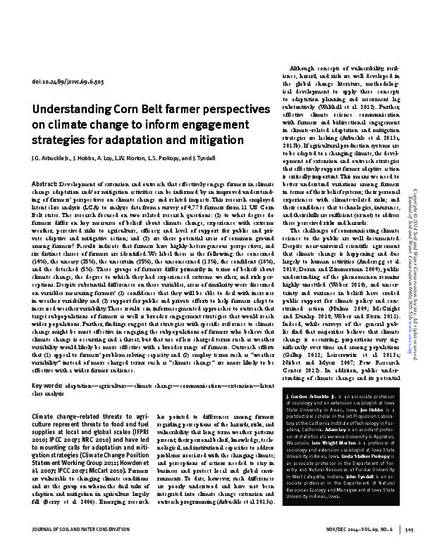
Development of extension and outreach that effectively engage farmers in climate change adaptation and/or mitigation activities can be informed by an improved understanding of farmers' perspectives on climate change and related impacts. This research employed latent class analysis (LCA) to analyze data from a survey of 4,778 farmers from 11 US Corn Belt states. The research focused on two related research questions: (1) to what degree do farmers differ on key measures of beliefs about climate change, experience with extreme weather, perceived risks to agriculture, efficacy, and level of support for public and private adaptive and mitigative action; and (2) are there potential areas of common ground among farmers? Results indicate that farmers have highly heterogeneous perspectives, and six distinct classes of farmers are identified. We label these as the following: the concerned (14%), the uneasy (25%), the uncertain (25%), the unconcerned (13%), the confident (18%), and the detached (5%). These groups of farmers differ primarily in terms of beliefs about climate change, the degree to which they had experienced extreme weather, and risk perceptions. Despite substantial differences on these variables, areas of similarity were discerned on variables measuring farmers' (1) confidence that they will be able to deal with increases in weather variability and (2) support for public and private efforts to help farmers adapt to increased weather variability. These results can inform segmented approaches to outreach that target subpopulations of farmers as well as broader engagement strategies that would reach wider populations. Further, findings suggest that strategies with specific reference to climate change might be most effective in engaging the subpopulations of farmers who believe that climate change is occurring and a threat, but that use of less charged terms such as weather variability would likely be more effective with a broader range of farmers. Outreach efforts that (1) appeal to farmers' problem solving capacity and (2) employ terms such as “weather variability” instead of more charged terms such as “climate change” are more likely to be effective with a wider farmer audience.
Available at: http://works.bepress.com/john_tyndall/56/

This article is published as Arbuckle, J. Gordon, Jon Hobbs, A. Loy, L. Wright Morton, Linda Stalker Prokopy, and John Tyndall. "Understanding Corn Belt farmer perspectives on climate change to inform engagement strategies for adaptation and mitigation." Journal of Soil and Water Conservation 69, no. 6 (2014): 505-516. doi: 10.2489/jswc.69.6.505. Posted with permission.